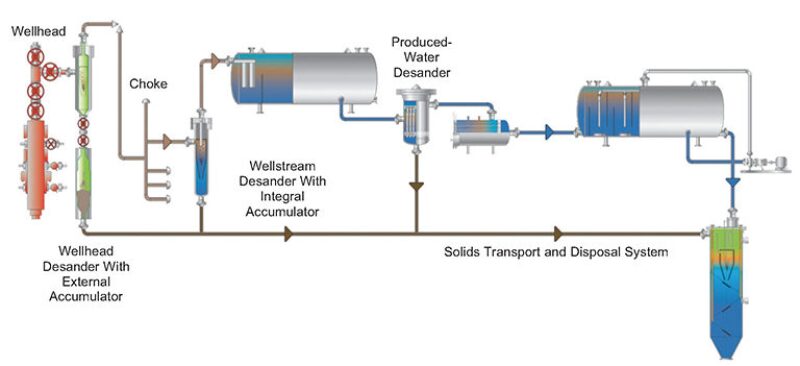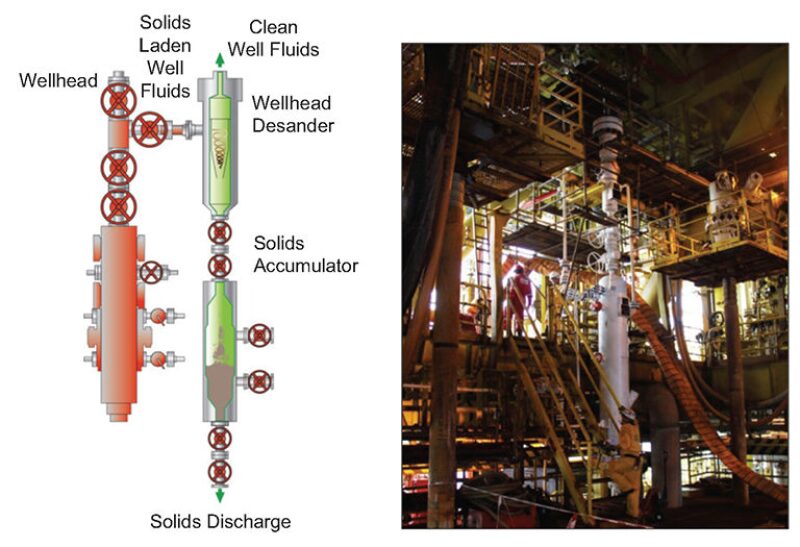Traditionally, sand-control equipment is used to prevent sand from entering the wellbore. This technique can be termed “exclusionary.” An alternative is to produce solids with the well fluids and separate them at the surface. This technique is termed “inclusionary” because the solids freely flow with the fluids to the surface. Exclusionary techniques protect production tubulars, wellhead chokes, flowlines, and facilities equipment. However, the buildup of solids near the wellbore increases skin damage, which reduces inflow. Allowing the sand to flow freely with the well fluids reduces skin damage, thus sustaining or increasing inflow.
Introduction
Several production companies have started to integrate facilities sand management into their sand-control portfolio. Equal merit is given to sand separation at the surface facilities and to completion technologies, to determine which approach provides sustained hydrocarbon production. Gravel-pack and screen completions have a well-established installation and operating base and form the majority of conventional sand control. While controlling sand production in numerous wells, these techniques may still pass sand with diameter of <50–125 µm under normal operating conditions, and this sand interferes with facilities operations. In the case of a completion failure, the sand amount and particle size may increase rapidly, leading to production restrictions or damaged equipment.
The necessity for a technology that could protect surface-facilities equipment (e.g., chokes, flowlines, pumps, separators, and valves) in cases of completion failure, openhole completion, or rapid unplanned sand production led to the development of the multiphase desander for solids removal at the wellhead.
Sources, Characteristics, and Problems of Produced Solids
In comparing exclusion approaches (i.e., completions or production limits) vs. surface separation methodologies for produced solids, it is necessary to clarify the exact nature of the solids being treated. Produced solids are inorganic, insoluble, nondeformable particulate materials accompanying hydrocarbon-fluids production. These solids are produced from oil, natural-gas, water, or multiphase wells.
Inorganic particulates that are produced at sufficient size and concentration to require exclusion or separation treatment are generally termed “produced solids.” This material can be broadly classified into two categories: indigenous (natural) material and foreign (artificial) material.
Natural Solids. Natural solids arise from the indigenous reservoir minerals. Broadly, these are sands, which are detrital grains of mineral oxides (e.g., SiO2), and clays, which are hydrous aluminum silicates that may be detrital or authigenic. Sand particles are the load-bearing solids of the formation, while fines (clay) are not part of the mechanical structure.
The majority of sand produced has a specific gravity averaging 2.65. These particles have high angularity, leading to poor shape factors (approach to roundness). The angularity helps in the grain-to-grain locking necessary for good gravel-pack filtering. However, the high surface area because of the angularity has been shown to detrimentally stabilize oil emulsion, making oil/water separation more difficult. In addition, an increase in particle sharpness increases the erosion potential. The average size varies from well to well, even within the same formation, but sand particles typically are in the 50- to 150‑µm range. Solids concentration will vary day to day within the same well, but, even with a good completion, a sand-prone well may produce 5 ppm by volume sand. At this concentration, a 10,000-B/D well will produce 5 B/D of sand, which weighs 2100 kg. Clays have a similar specific gravity but smaller particle size and usually are present in lower concentrations. The plate-like structure of clay and its very fine particle size (<10 µm) make gravity or enhanced-gravity separation difficult. Typically, clay particles will flow through the production system in the oil phase to report in the basic sediment and water.
Artificial Solids. Artificial solids are foreign material introduced by external intervention. This is a broad category that can include fracture sand or proppant, drill mud, cement fines, corrosion products, gravel-pack material, and injection fines. Sand from hydraulic fracturing and mud particles from overbalanced drilling have a very high concentration (1–3 vol%) immediately after workover. This drops to near 0 ppm by volume once the reservoir fluids have flushed the well skin. Gravel-pack solids are produced only upon catastrophic failure. A gravel pack does allow small particles of formation material to pass.
Facilities Sand-Management Methodology
Incorporating solids management into surface-facility design requires more than just installing a separating device. The separated solids may require central collection, cleaning, measurement and monitoring, storage, transport to a disposal site, overboard discharge, or injection disposal. Surface-facilities sand handling can be segmented into five unit-process areas: separation, collection, cleaning, dewatering, and transportation.
- Separation: Separation is the unit process of diverting the solids and liquids contained in a multiphase stream to different locations.
- Collection: Upon separation, the solids are collected into a central location and physically isolated from the production process.
- Cleaning: In many locations, the sand may require cleaning of adsorbed hydrocarbons subsequent to disposal. Dedicated sand-cleaning systems based on attrition scrubbing with or without chemicals, or thermal treatment, are available as modular add-on packages or are integrated into the separation system.
- Dewatering: The total volume of sand slurry transported to disposal can be reduced greatly by dewatering. This involves removing liquids from the collected solids slurry.
- Transportation: Transportation encompasses the removal, hauling, and disposal of the solids.
Methods for Controlling Produced Solids
Production Limits. The simplest method of solids management is to adopt a conservative approach of zero sand production. This approach attempts to establish a maximum sand-free production rate on the basis of drawdown criteria. Using well tests, a map of reservoir pressure vs. bottomhole pressure determines the regions of sand-free production. While the approach requires minimal capital expenditures, it has the drawback of reducing inflow, hence directly reducing hydrocarbon production.
Downhole Equipment. To maximize hydrocarbon production, the most common method of sand control is installation of equipment to exclude sand from entering the wellbore. Mechanical retention in the form of screens or slotted liners restrains sand from entering with well fluids.
Chemical sand-control techniques are available to cement the formation sand grains together for a radius several feet from the wellbore. Plastic consolidation by use of epoxies, furans, or phenolic resins forms a bond between the existing formation particles, creating a filter barrier to sand inflow.
Many combinations or offshoots of these techniques can be used for effective sand control.
Surface Facilities: Conventional Design. Conventional surface-facility design incorporates equipment to handle normal sand production; however, maintenance intervention is still required. These measures include erosion-resistant choke design and materials, impact or sacrificial tees in flowlines, profile instrumentation in separators, and sand jet or suction devices for free-water-knockout, two-phase, three-phase, and heater-treater separators. All of these techniques, while growing in robustness with proper material selection and improved fluid-flow design, still require manual intervention for maintenance.
Chokes and flowlines must be protected from erosive conditions that lead to catastrophic failure.
Solids cause multiple problems in gravity-based production separators. As large solids (>50 µm) settle in separating vessels, the residence time for oil/water separation is decreased, resulting in a reduction in throughput. Periodic shutdown for manual removal of solids may be required to restore the production rate.
Surface Facilities: Solids-Separation Design. The best location for surface solids removal is before the choke, as shown in Fig. 1. Prechoke removal protects all downstream equipment, including the choke orifice, flowlines and piping, production separators and treaters, heat exchangers, control valves, and -produced-water-treating equipment. Solids upstream of the choke are at the highest temperature of the facility and uncontaminated by most production chemicals, rendering them easier to clean once separated before the choke. In regard to cyclonic technology, solids are most easily removed from multiphase streams as the increased gas void fraction reduces the continuous-phase viscosity and density, permitting increased settling velocity of the solids.
If facility location (e.g., subsea) or space constraints prohibit removal of solids upstream of the choke, then a multiphase (wellstream) desander can be installed downstream of the choke before the production separators, as shown in Fig. 1. This location has advantages similar to those listed previously; however, the choke (bean) will not be protected.

Wellhead Desander Design
Multiphase desanders operate on the basis of a combination of hydraulic and pneumatic cyclonic principles. As with all cyclonic devices, pressure energy is converted to radial and tangential acceleration to impart centrifugal forces on the contained fluids. The increased forces accelerate the separation of phases with different densities. In the case of a multiphase desander, solids are separated from the gas/liquid mixture. The forces imparted are 400–5,000 times greater than gravity, leading to rapid separation of solids from fluids and also rendering the cyclone unaffected by external motion or orientation. The separated solids collect into an accumulator chamber (external or integral) for periodic isolation and batch discharge, while the well fluids maintain continuous flow, as shown in Fig. 2.

The initial few dozen installations of multiphase desanders occurred in critical applications where downhole equipment provided insufficient protection to topside equipment. With increased use and improved prediction models, the multiphase desander has become a valuable tool in overall sand management.
This article, written by Editorial Manager Adam Wilson, contains highlights of paper SPE 164645, “Sand-Management Methodologies for Sustained Facilities Operations,” by C. Hank Rawlins, SPE, eProcess Technologies, prepared for the 2013 SPE North Africa Technical Conference and Exhibition, Cairo, 15–17 April. The paper has not been peer reviewed.
